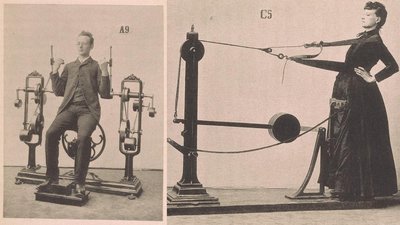You'd be forgiven for never wondering about the history of gym machines. If you are anything like most gym-goers, drowning out the brutal task of half an hour on the recumbent bike with distracting upbeat music and trashy magazines is the most you can muster.
But the most mundane and rote habits of our daily life can belie a fascinating and not regularly considered history, and the machine is no exception.
The Unlikely Beginnings of a Gym Craze
Such is the case of Dr. Gustav Zander, the Swedish physician who helped pioneer mechanotherapy, or the promotion of health and healing through exercise apparatus. He wasn't the first to see positivity in using machines to aid in health, but his connection of regular exertion through machines to health and well-being was certainly a novel idea in an age when blood-letting and noxious humors were still pretty standard.

Movement as a therapeutic agent did already have its proponents. Zander was a follower of Swedish physical education guru Per Henrik Ling's gymnastics-based "movement cure," for instance. But incorporating machinery opened up Zander's therapeutic movement to those with injuries or deformities, as well as those just not in good enough shape for calisthenics.
Born in Stockholm in 1835, Dr. Zander would explore the connection between mechanics of the body and muscle-building while in medical school in Sweden in the early 1860s. He quickly established the Zander Institute in Stockholm, a state-supported institute that used his machines to help workers correct physical impairments. He would further develop these devices, going on to win a gold medal at the 1876 Centennial Exhibition in Philadelphia for his exercise machines.
By the time the first edition of "Dr. G. Zander's medico-mechanische Gymnastik" was published in 1892, he was well on his way to establishing Zander Institutes across the globe.
Strength and the Rise of the Machine Age
Dr. Zander's contributions to this perennial gym craze began in the midst of heavy industrialization in the latter part of the 19th century. For the first time, a sizable chunk of society was now working in offices and "laboring" without physical exertion.
At the same time, industrialization brought with it rapid mechanization. It's no wonder that his show at the Centennial Exhibition would help ignite a craze in the United States for his machines. By the turn of the century, his machines were in health spas across the country, emblematic of an upscale clientele looking for status symbols to reflect their leisurely lifestyles and exemption from physical labor.

To modern eyes, Dr. Zander's contraptions seem bizarre, at least partially because of the formal attire of the people operating them. But their importance wasn't lost on Arthur Jones, the creator of the Nautilus line and the direct forefather of today's gym machines. "The man was a genius," Jones once said of Zander. "His only problem was that he lived about a century ahead of his time, at a time when very few people cared about exercise and even fewer knew anything about it."
Gym machines and the names on them have changed over the decades, but the philosophy Zander's creations represent is as crucial now as it was 150 years ago. Each one was an attempt to take strength and health out of the realm of elite athletics and bring it to those who could benefit from it most in their daily lives. Today, pick out the most befuddling machine in the gym, and knock out a couple of hard sets in his honor.
Article and images reprinted with permission from Smithsonian Libraries.

